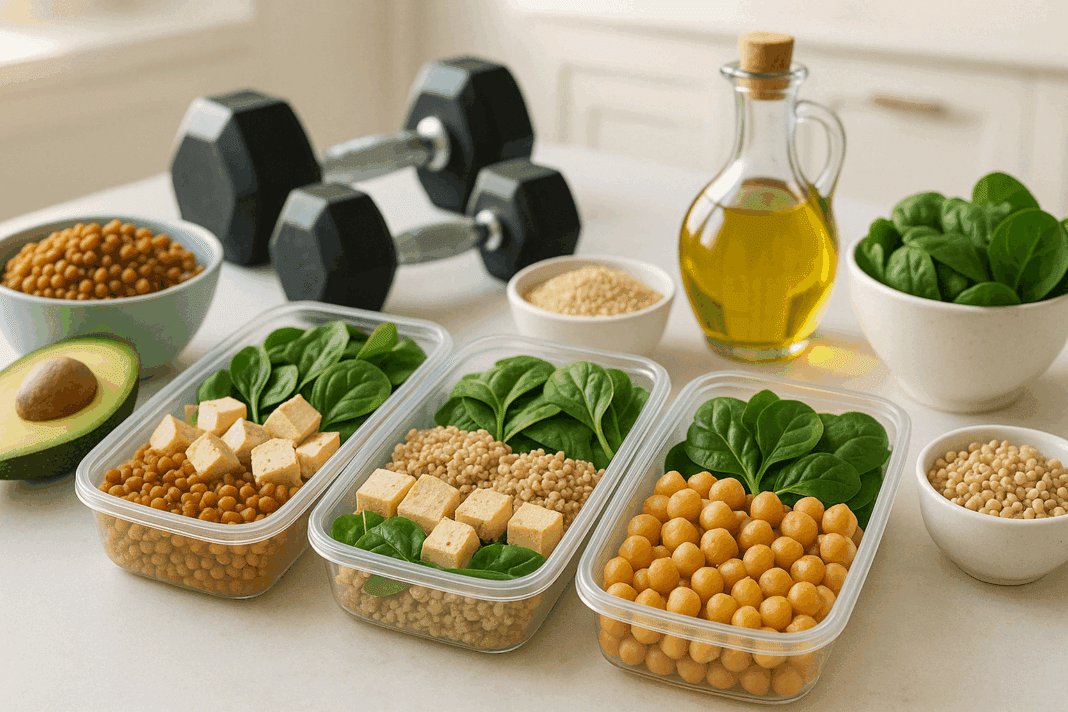Building muscle isn’t just about lifting heavy weights or following the latest strength-training split. At the core of any effective bodybuilding strategy is nutrition, and even more importantly, consistency in how that nutrition is delivered. This is where bodybuilding simple meals come into play. By focusing on easy anabolic recipes that support muscle recovery, fuel strength gains, and promote healthy bulking, athletes and fitness enthusiasts can reach their physique goals without overcomplicating their daily routines. For those navigating a busy lifestyle, developing sustainable bodybuilding meal prep habits can be the difference between stagnation and steady progress.
You may also like: Smart Meal Prep for Weight Loss: Expert-Approved Lunch Ideas and Recipes to Stay on Track
In this guide, we’ll explore the practical science behind anabolic meals, the pros and cons of popular eating approaches like the ketogenic diet vs low carb plans, and how to build delicious, effective bodybuilding menu ideas that don’t require chef-level skills. We’ll also address key concerns like whether a low carb diet or keto diet is sustainable for bulking, and why mindful eating can optimize your gains.
Why Simplicity Matters in Bodybuilding Nutrition
Bodybuilders often fall into the trap of chasing complex meal plans or exotic ingredients, assuming that more sophisticated means more effective. In reality, the opposite is often true. Easy meals for bodybuilding are not only more sustainable but also help reduce cognitive load and meal prep fatigue. When you know exactly what to eat and how to prepare it quickly, you’re far more likely to remain compliant with your diet, especially over the long term.
Research has consistently shown that dietary adherence is one of the most powerful predictors of success in body composition change. A 2020 study published in Nutrients found that consistency in dietary intake and macronutrient balance had a stronger impact on lean mass development than any particular diet trend. Easy-to-follow bodybuilder recipes allow athletes to meet their protein and calorie needs without spending hours in the kitchen or falling off track due to decision fatigue.
Moreover, bodybuilding simple meals make it easier to track macros precisely, especially when prepping meals in batches. With fewer ingredients and standardized recipes, it becomes easier to calculate caloric and protein intake down to the gram—an essential step for those with serious physique goals.
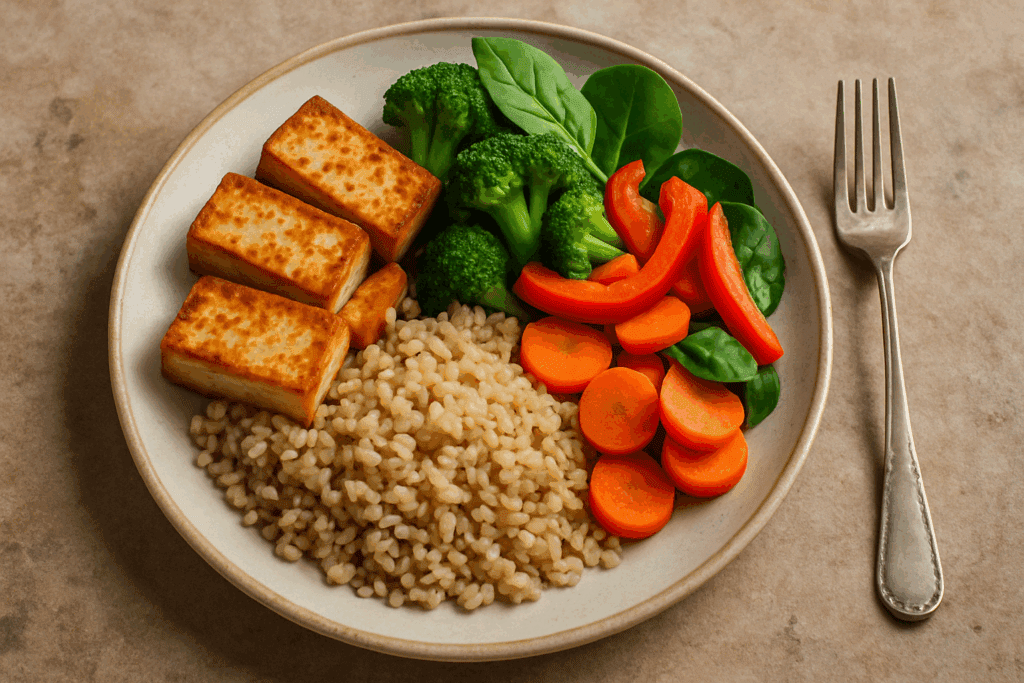
Designing Anabolic Meals for Strength and Muscle Growth
At the heart of every effective bodybuilding meal is the anabolic equation: sufficient protein, enough energy (calories), and key nutrients that support recovery and hormone health. While protein is the star of the show, it’s the combination of ingredients that ensures your body is in a constant state of repair and growth.
For instance, a well-balanced bulking lunch might include lean protein (like grilled tofu, seitan, or tempeh), slow-digesting carbs (such as sweet potatoes or quinoa), and a healthy fat source (like olive oil or avocado). Add some leafy greens or cruciferous vegetables, and you have a nutrient-dense, muscle-supportive meal that supports both performance and long-term health.
These bodybuilding food ideas don’t require fancy sauces or exotic cooking techniques. Instead, they rely on whole-food basics that can be combined into customizable meals for any training phase, whether you’re bulking, cutting, or maintaining. Easy anabolic recipes should also consider glycemic control, digestive comfort, and micronutrient density—all factors that can influence recovery and athletic performance.
Meal Prep Meals for Bodybuilding: Your Weekly Strategy
One of the most powerful tools for any bodybuilder is strategic meal prep. Not only does this approach help control portions and prevent impulse eating, but it also saves time and removes the guesswork from your day-to-day fueling. When planning your bodybuilding meal prep, consider the following principles:
- Batch cook your staple proteins. Whether it’s plant-based options like lentils, chickpea patties, or tofu, having these ready-to-go reduces prep time throughout the week.
- Cook grains in bulk: Brown rice, farro, and oats make excellent complex carb bases that keep well in the fridge.
- Mix and match. Use prepped components to create bodybuilding menu ideas that rotate flavors and textures without starting from scratch.
By designing your meal prep meals for bodybuilding with modular ingredients, you increase variety while preserving simplicity. This method also allows you to adjust calorie levels depending on whether you’re cutting or bulking, with minimal stress.
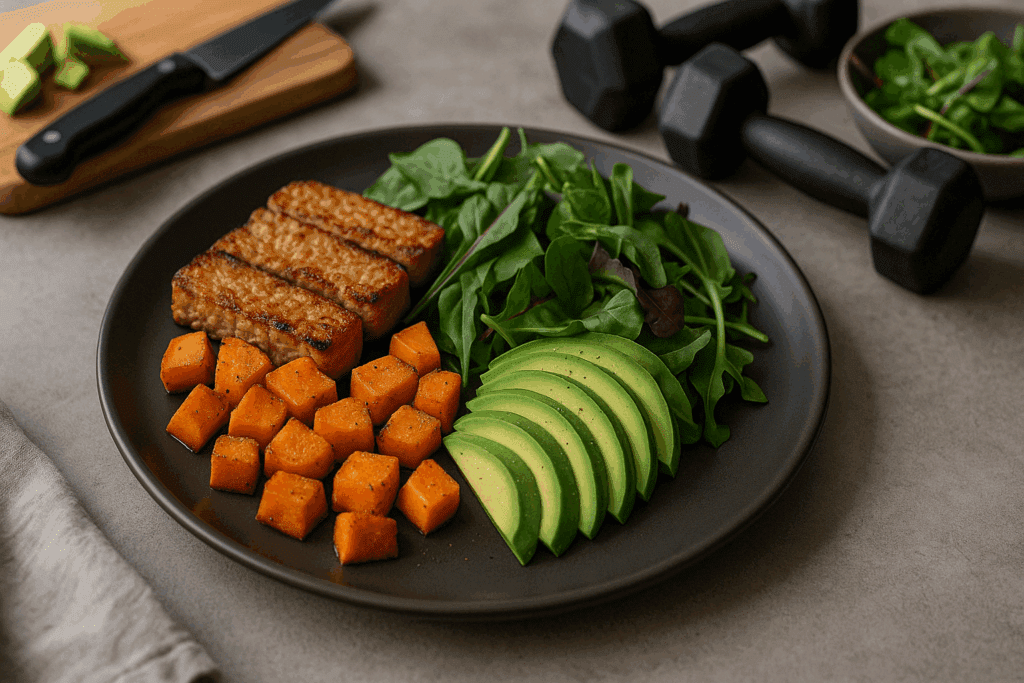
Bodybuilding Diet Recipes that Actually Taste Good
Too often, bodybuilder recipes are dismissed as bland or repetitive. However, flavor doesn’t have to be sacrificed in pursuit of gains. When prepared thoughtfully, bodybuilding diet recipes can be satisfying, delicious, and even crave-worthy—all while staying aligned with your macros.
Take, for example, a lentil and roasted vegetable bowl drizzled with tahini and lemon. This dish is not only packed with plant protein and fiber but also offers antioxidant support from the vegetables and heart-healthy fats from sesame seeds. Or consider a high-protein tofu scramble cooked with turmeric, spinach, and nutritional yeast for a savory anabolic breakfast. These meals check the boxes for both nutrition and taste, proving that simple doesn’t mean boring.
Incorporating bold spices, fresh herbs, and acidic elements (like citrus or vinegar) can elevate even the most basic meals. The key is to strike a balance between ease and flavor—enhancing your meals without overcomplicating them.
Navigating Carbs: Is Keto a Good Diet for Bodybuilders?
With the rise of carb-restrictive trends, many fitness enthusiasts are left wondering about the differences between the ketogenic diet vs low carb eating styles and whether they fit into a bodybuilding lifestyle. The reality is nuanced.
When comparing the keto diet vs low carb diet approaches, it’s essential to understand that both limit carbohydrate intake, but to different degrees. A standard ketogenic diet typically limits net carbs to around 20–50 grams per day, pushing the body into ketosis. In contrast, a low carb diet may allow anywhere from 50 to 150 grams of carbs daily.
So, is keto a low carb diet? Technically yes, but not all low carb diets are ketogenic. The stricter keto approach can reduce insulin levels and support fat loss, which may appeal to bodybuilders in cutting phases. However, for bulking and muscle-building phases, the extreme carb restriction of keto can limit performance and recovery. Carbohydrates are the body’s preferred source of fuel during high-intensity resistance training, and their absence can hinder strength gains and muscle fullness.
As a result, while some lifters experiment with keto or low carb diet keto diet hybrids, many find that strategic carb intake (especially around training) is critical for muscle development. For most bodybuilders, the question isn’t “is keto no carbs” (which it technically isn’t), but rather “is a keto diet sustainable for my training needs?”
Bodybuilding Menu Ideas That Support Long-Term Success
Long-term progress requires more than just short-term discipline. That’s why your bodybuilding menu ideas should reflect both nutritional adequacy and lifestyle compatibility. The most effective diets are those that fit seamlessly into your day, are enjoyable to eat, and leave you feeling satisfied.
Great bodybuilding food ideas rotate around a few core principles:
- Prioritize high-quality protein at each meal to stimulate muscle protein synthesis.
- Include complex carbohydrates and fiber to support energy and digestive health.
- Don’t shy away from healthy fats, which play crucial roles in hormone production and satiety.
By centering your meals around these principles, you create a framework that can evolve as your goals change. For example, during a bulking phase, your bulking lunch might include extra portions of legumes, nut-based dressings, and whole grains. During a cutting phase, you might reduce overall calories by swapping starchy carbs for non-starchy vegetables and using leaner protein options.
Remember that simplicity doesn’t mean rigidity. Flexible meal planning allows you to make room for social events, cravings, and life’s inevitable curveballs without sacrificing your gains.
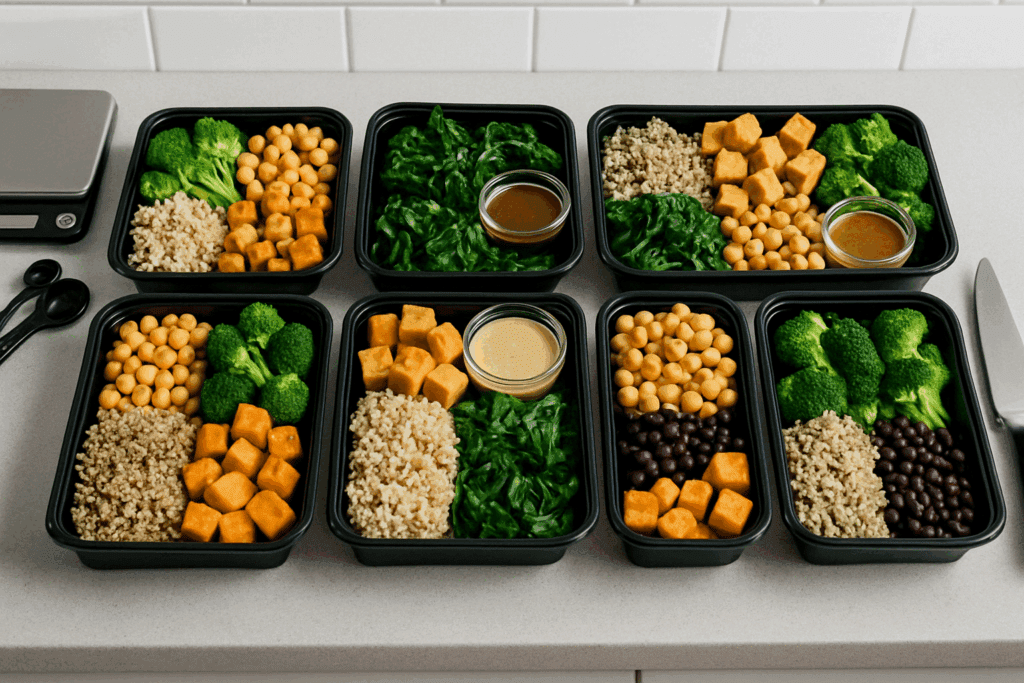
Is a Keto Diet Sustainable in the Long Run for Bodybuilders?
While keto has earned a reputation for rapid fat loss, the question remains: is a keto diet sustainable for individuals whose primary goal is hypertrophy and strength? Research suggests that the answer depends heavily on individual variability, training type, and overall dietary strategy.
From a physiological standpoint, a well-formulated ketogenic diet can preserve lean mass during weight loss, especially when combined with resistance training. However, studies have shown that muscle glycogen levels remain chronically low on keto, which may impair power output and endurance over time.
Moreover, is keto a good diet for bulking athletes who require high calorie and high-volume meals? The restrictive nature of keto can make it challenging to consume sufficient energy without experiencing satiety too early. Additionally, high-fat meals can slow gastric emptying, potentially causing digestive discomfort when large volumes of food are consumed.
Therefore, for most lifters, moderate carbohydrate intake (as seen in a low carb diet keto diet variation) is a more sustainable long-term approach. This allows for carb cycling around workouts while still maintaining lower baseline insulin levels. Rather than asking “is keto no carbs,” it’s more productive to ask how strategic carb inclusion can enhance performance while maintaining metabolic flexibility.
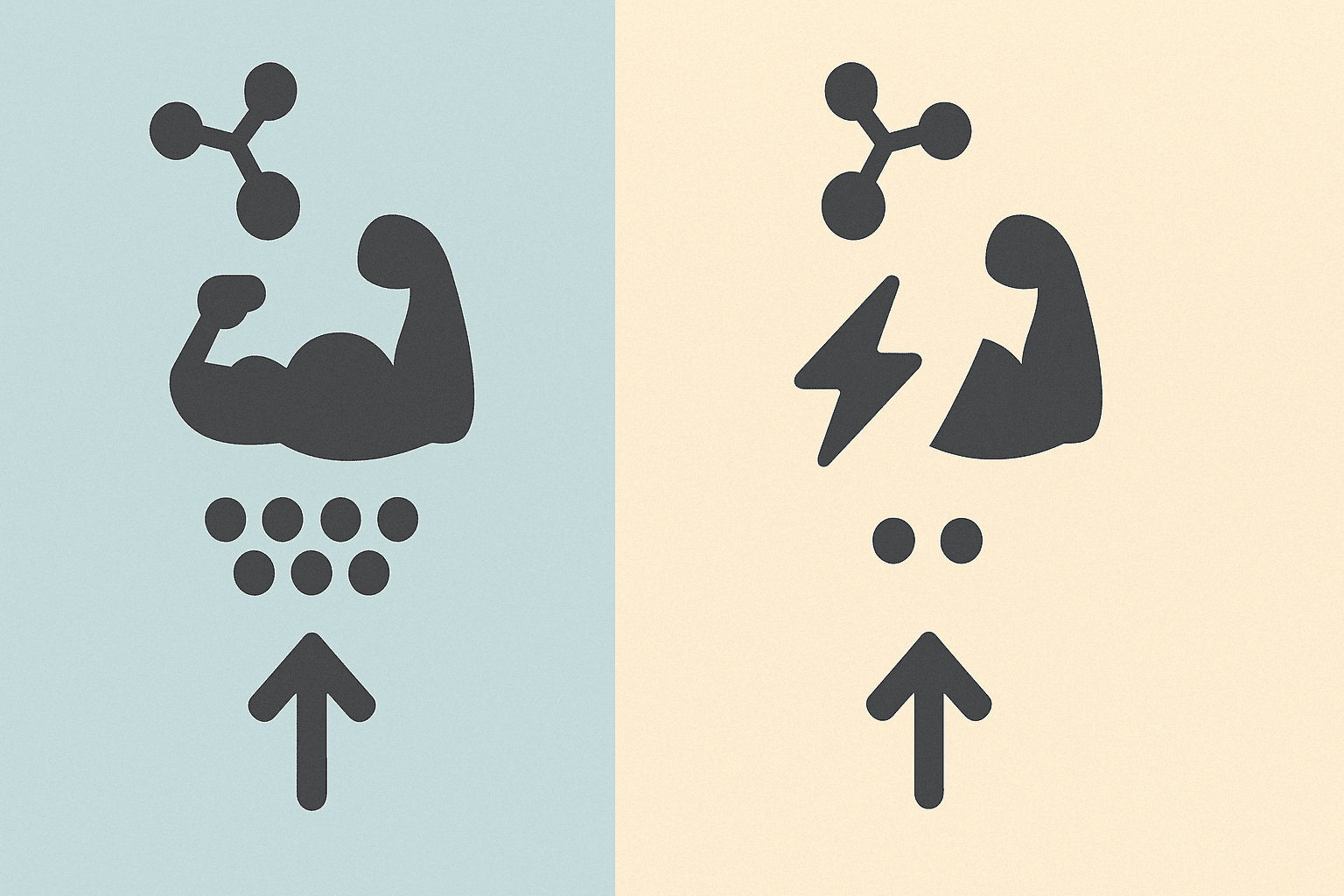
Mindful Eating: The Missing Link in Anabolic Nutrition
Amid all the talk of macros, meal prep, and anabolic meals, one often-overlooked factor is the how of eating. Mindful eating can dramatically enhance the bodybuilding experience, improving not only digestion and nutrient absorption but also long-term adherence and satisfaction.
By slowing down during meals, paying attention to hunger cues, and truly savoring your food, you create a healthier relationship with nutrition. This helps prevent binge-restrict cycles, reduces emotional eating, and promotes better portion control—all of which are critical for both bulking and cutting phases.
Bodybuilding simple meals are especially conducive to mindful eating, as their uncomplicated nature makes it easier to focus on the sensory experience of eating. Whether you’re enjoying a homemade chickpea curry or a quick tempeh stir-fry, being present at mealtime can enhance the anabolic benefits of your food beyond its nutritional content.
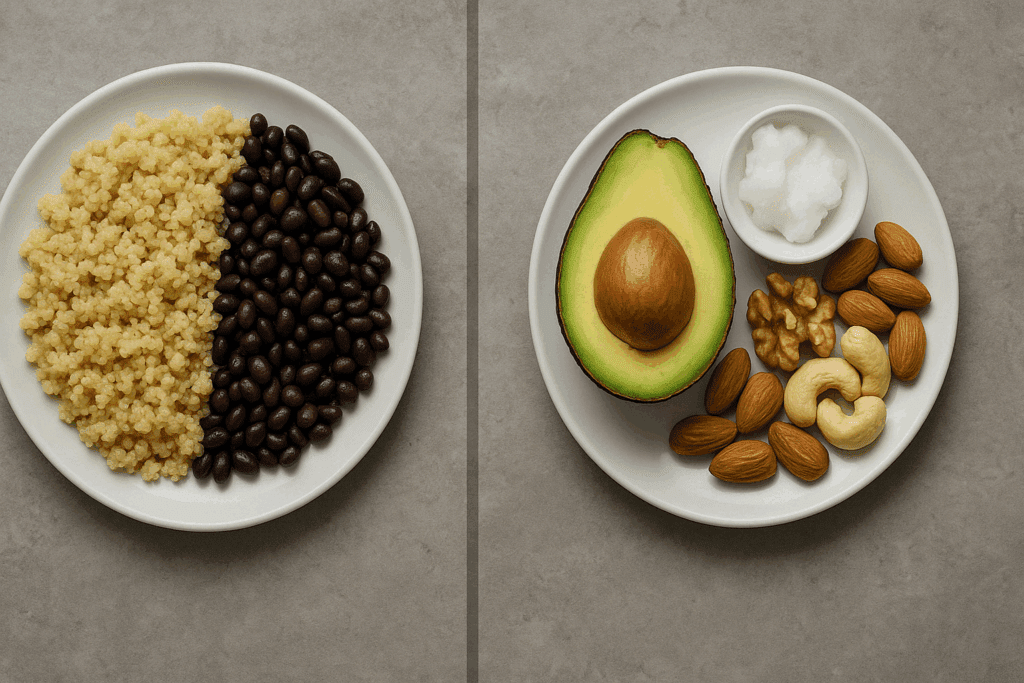
Frequently Asked Questions: Bodybuilding Simple Meals, Meal Prep, and Anabolic Nutrition
1. How can I prevent boredom when eating bodybuilding simple meals every day?
Monotony is one of the biggest threats to dietary adherence in bodybuilding. Even when meals are simple, rotating flavors, seasonings, and preparation methods can make a huge difference in your long-term consistency. For instance, using global flavor profiles—like Mediterranean, Thai, or Mexican—lets you transform basic ingredients into a variety of easy meals for bodybuilding without altering the macro content too much. Additionally, preparing different versions of your favorite anabolic meals using seasonal vegetables or alternate grains can add diversity while keeping your plan simple. Over time, this flexibility turns bodybuilding simple meals into a culinary routine that is not only effective but enjoyable.
2. What are some overlooked ingredients that can elevate bodybuilding meal prep?
Many lifters focus on the obvious staples like oats, rice, and chicken alternatives, but there are plenty of less common ingredients that can improve both taste and nutrition in bodybuilding meal prep. Fermented foods like kimchi or sauerkraut can enhance digestion and add a flavorful punch to anabolic meals. Hemp seeds, nutritional yeast, and miso paste offer both taste and unique micronutrients that many bodybuilder recipes lack. These ingredients are easy to integrate into your weekly meal prep meals for bodybuilding and provide a welcome contrast to more traditional fare. By expanding your pantry, you open the door to bodybuilding menu ideas that are nutrient-dense and exciting.
3. How do I adjust bodybuilding diet recipes when cutting versus bulking?
The difference between cutting and bulking often comes down to portion control and ingredient density rather than completely different recipes. For cutting, use lower-calorie, high-volume vegetables like zucchini, cauliflower rice, and leafy greens to replace calorie-dense carbohydrates. In contrast, a solid bulking lunch might include calorie boosters like roasted chickpeas, whole grains, and tahini-based dressings to increase energy without sacrificing nutrient quality. The core bodybuilding diet recipes can stay the same, but macronutrient ratios and portion sizes shift based on your current goal. Think of it as scaling your easy meals for bodybuilding rather than overhauling your entire food philosophy.
4. Can bodybuilding simple meals support both muscle gain and digestive health?
Absolutely. Many athletes underestimate the role of digestion in achieving optimal physique goals. Poor gut health can hinder nutrient absorption, making even the most calculated bodybuilding food ideas less effective. Integrating fiber-rich plant foods, fermented ingredients, and hydrating vegetables into your bodybuilding meal prep supports not only digestion but also overall wellness. When your gut functions efficiently, the body better utilizes protein and calories for muscle repair, making your anabolic meals far more impactful.
5. How can I incorporate social eating into a bodybuilding-focused meal plan?
Eating out or dining with friends can feel like a disruption to bodybuilding meal prep, but it doesn’t have to be. Planning ahead—such as eating a smaller meal earlier in the day or bringing your own dish to gatherings—can help you stay within your macros without drawing attention. Many restaurants offer customizable bowls or salads that can mimic your go-to bodybuilding simple meals with just a few tweaks. Additionally, practicing mindful eating in social settings ensures that even less structured meals don’t derail your progress. The key is flexibility: your bodybuilding menu ideas should accommodate life, not restrict it.
6. What are some strategies to maximize efficiency during weekly meal prep?
Efficiency is crucial when preparing meal prep meals for bodybuilding on a tight schedule. One approach is to group ingredients by cooking method—roast all your vegetables at once, steam your grains simultaneously, and bake or pan-sear proteins in bulk. Another strategy is to assemble modular meals using interchangeable components that can be mixed and matched throughout the week. This reduces repetition while preserving the simplicity of easy meals for bodybuilding. Investing in tools like multi-compartment containers, food processors, and high-quality nonstick pans can also streamline your prep time and make cleanup easier. When bodybuilding food ideas are organized and efficient, your chances of long-term success skyrocket.
7. How do I ensure I’m getting enough variety while eating mostly bodybuilding diet recipes?
Variety in bodybuilding diet recipes doesn’t mean constant reinvention. Instead, focus on diversifying your protein, fat, and carbohydrate sources within the same recipe frameworks. Swap quinoa for brown rice, use lentils instead of tofu, or rotate leafy greens like kale, arugula, and romaine. Even small changes like alternating sauces or spices can transform your go-to bodybuilding simple meals into something fresh. Over time, this approach not only enhances nutrient diversity but also keeps your palate engaged without overwhelming your routine.
8. Are there psychological benefits to sticking with bodybuilding simple meals?
Yes, and they’re often overlooked. Simplifying your food choices reduces decision fatigue, a common barrier to long-term compliance. When your daily meals become habitual, you free up cognitive bandwidth to focus on training, recovery, or other life priorities. Additionally, consistent eating patterns can regulate appetite hormones and stabilize mood, which contributes to a healthier relationship with food. Many athletes find that easy meals for bodybuilding reduce stress, anxiety, and emotional eating by creating structure and predictability. Simplicity, in this case, supports not only physical goals but mental clarity as well.
9. What role do plant-based anabolic meals play in modern bodybuilding culture?
Plant-based bodybuilding is no longer niche; it’s becoming a respected and evidence-supported path to muscle growth. With creative bodybuilding menu ideas that include legumes, soy derivatives, whole grains, and nuts, plant-based anabolic meals can match or even surpass the nutrient density of traditional diets. Bodybuilder recipes that rely on plants tend to be anti-inflammatory, easier on digestion, and rich in fiber—a triple threat for both performance and health. Furthermore, emerging research supports the effectiveness of plant protein blends in stimulating muscle protein synthesis when consumed in adequate amounts. As more athletes seek sustainable and ethical approaches, plant-based bodybuilding food ideas are becoming more mainstream and effective.
10. How do I adapt my bulking lunch when my appetite drops due to intense training or stress?
During high-stress periods or intense training blocks, appetite suppression is a real challenge. In these instances, focus on energy-dense bodybuilding food ideas that don’t rely on large volumes to meet your needs. Smoothies made with oats, nut butter, and protein powder are excellent liquid options that can serve as meal prep meals for bodybuilding. You can also add calorically rich toppings like dried fruit, tahini, or avocado to traditional bulking lunch staples. Choosing easily digestible bodybuilding simple meals and eating smaller portions more frequently throughout the day can help you meet your caloric goals without discomfort. It’s about working with your body’s signals while keeping your meals functional and efficient.

Bringing It All Together: The Power of Simple, Strategic Eating
In the world of physique development, there are countless diets, strategies, and supplement stacks to choose from. But in the end, it’s the basics—done consistently and intelligently—that lead to real, lasting transformation. Easy meals for bodybuilding are not a compromise; they are the foundation.
By embracing easy anabolic recipes, building a smart bodybuilding meal prep routine, and avoiding the extremes of the ketogenic diet vs low carb debate, you create a sustainable, performance-driven nutrition plan. Integrating mindful eating, strategic macro planning, and enjoyable food choices ensures that your diet supports not only your strength and muscle gains but also your overall well-being.
So the next time you’re planning a bulking lunch or scanning for new bodybuilder recipes, remember: simplicity, consistency, and balance always win. Whether you’re deep into a cutting phase or powering through a bulking cycle, your meals should work for you—not the other way around.
Because in bodybuilding, as in life, success is often built one simple, solid meal at a time.
Was this article helpful? Don’t let it stop with you. Share it right now with someone who needs to see it—whether it’s a friend, a colleague, or your whole network. And if staying ahead on this topic matters to you, subscribe to this publication for the most up-to-date information. You’ll get the latest insights delivered straight to you—no searching, no missing out.
Further Reading:
57 Meal Prep Recipes For Muscle Building & Fat Loss
What to Eat and Avoid If You’re Trying to Build Muscle
Disclaimer
The information contained in this article is provided for general informational purposes only and is not intended to serve as medical, legal, or professional advice. While NewsHealthWatch strives to present accurate, up-to-date, and reliable content, no warranty or guarantee, expressed or implied, is made regarding the completeness, accuracy, or adequacy of the information provided. Readers are strongly advised to seek the guidance of a qualified healthcare provider or other relevant professionals before acting on any information contained in this article. NewsHealthWatch, its authors, editors, and contributors expressly disclaim any liability for any damages, losses, or consequences arising directly or indirectly from the use, interpretation, or reliance on any information presented herein. The views and opinions expressed in this article are those of the author(s) and do not necessarily reflect the official policies or positions of NewsHealthWatch.

